
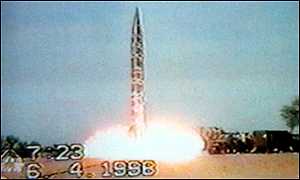
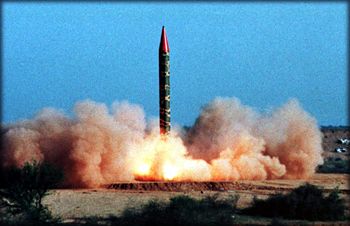

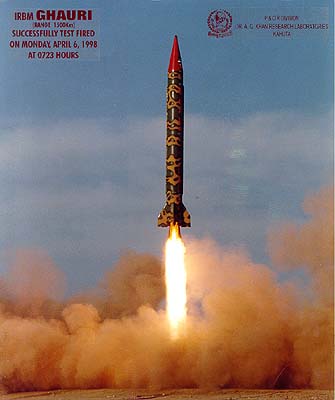
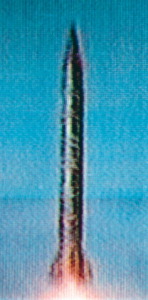



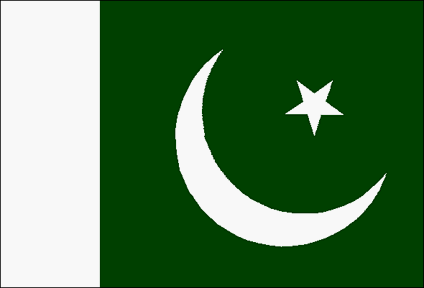


Last changed 6 August 2001
The uranium enrichment facility that produces most of Pakistan's weapons material )(highly enriched uranium or HEU) is the gas centrifuge plant at KRL (A.Q. Khan Research Laboratories) at Kahuta, 50 km Islamabad. This facility, which employs 7,000 people including 2,000 scientists and researchers, began operating in the early 1980s, but suffered serious start up problems. A.Q. Khan announced that Kahuta was producing low enriched uranium in 1984. US intelligence believes that uranium enrichment exceeded 5% in 1985, and that production of highly enriched uranium was achieved in 1986. Kahuta has run essentially non-stop at enriching uranium since that time (though with varying numbers of gas centrifuges). At start-up Pakistan had reportedly manufactured 14000 centrifuges, but had only 1000 operating. By 1991 about 3000 machines were operating according to US intelligence. This implies a production capacity of 45-100 kg U-235/year depending on the tails concentration and production efficiency, enough for 3-7 implosion weapons. Shahryar Khan has said that the cost of Kahuta was relatively modest, less than $150 million[Albright and Hibbs 1992].
U.S. and former Pakistani government officials have said on many occasions that Pakistan voluntarily halted production of HEU at Kahuta in 1991. But instead of shutting down the plant, Pakistan simply reconfigured their enrichment cascade to produce low enriched uranium (LEU), thus continuing to perform the same amount of separative work. Since the production of this "middle product" between natural and highly enriched uranium requires most of the separative work required to produce HEU, this in effect stockpiled separative work units (SWUs) that Pakistan could recoup with comparatively little additional effort at a later time to produce HEU without loss in cumulative production in the end. Pakistan is known to have resumed HEU production no later than 1998 after the nuclear tests conducted that year (and possibly well before), thus the production of HEU forgone between 1991 and 1998 has been made up by now (probably before the end of 1999), and the effect is as if HEU production never halted.
Pakistan has built a second enrichment plant at Golra, 6 miles from Islamabad. It is expected to be even larger than Kahuta, with more advanced centrifuges. It may not yet have begun production though due to difficulty in obtaining the necessary parts now. In March 1996 the New York Times reported that China had sold Pakistan 5000 ring magnets suitable for use in gas centrifuges.
It is estimated that Pakistan produced about 210 kg (range 160 - 260 kg) of HEU up to the moratorium in 1991 [Albright and O'Neill 1998]. The current production capacity of Pakistan is approximately 110 kg per year (range 80 - 140 kg/year), and the cumulative production of HEU (less the HEU expended in the 1998 tests) is estimated at about 800 kg at the end of 2000 (range 665 - 940 kg) [Albright 2000]. Since a uranium weapon requires about 15 kg this equates to a potential for 53 weapons (range 44 - 62), although somewhat more than 15 kg may be used to produce more powerful and efficient weapons.
In April 1998 the unsafeguarded Kushab reactor began operating. This reactor is a heavy water-natural uranium reactor built with Chinese assistance and has an operating power of 50-70 MW. This reactor should be able to produce around 10-15 kg of plutonium a year at a 60-80% load factor (the fraction of the time the reactor actually operates) [Albright 1998b]. Through the end of 2000 approximately 10-28 kg is estimated to have been separated from the fuel, a figure that is strongly affected by how quickly the fuel is processed after irradiation, and the effectiveness of the separation plant. Pakistan has a pilot plutonium reprocessing plant called "New Labs" at the Pakistan Institute of Scientific and Technical Research (Pinstech) complex near Rawalpindi. Reportedly the New Labs facility was expanded during the 90s to handle the full fuel load from Kushab. CBS News reported on 16 March 2000 that US intelligence had found evidence (such as krypton-86 emissions) that Pakistan is reprocessing irradiated fuel from the Khushab reactor and recovering separated plutonium [Albright 2000]. Fission weapons require 4-6 kg of plutonium, so 2-7 weapons could have been manufactured from this material.
In addition to Kushab, Pakistan is also manufacturing reactor-grade graphite and has its own heavy water plant both of which may be used to build additional plutonium production reactors fueled with natural uranium. It currently possesses two power reactors - the Karachi Nuclear Power Plant (KANUPP) with an output of 137 MW electrical, and the Chasma Nuclear Power Plant (CHASNUPP) with an output of 300 MWe. CHASNUPP is a pressurized water reactor constructed by the China National Nuclear Corporation was completed in late 1995. CHASNUPP began operations in November 1999 and was connected to the power grid (run by the Karachi Electric Supply Company) on 14 June 2000. These reactors have produced 600 kg of plutonium in their spent fuel but this plutonium remains unseparated and under IAEA safeguards.
The Kushab reactor could also be used to produce tritium for boosted weapons. The production capacity for tritium would be on the order of 100 g per year if enriched uranium is used as fuel, enough to boost perhaps 20 weapons. Pakistan is known to be interested in tritium, having acquired a tritium purification and production facility, and 0.8 grams of pure tritium gas from West Germany in 1987, as well as even larger quantities of tritium from China.
According to A. Q. Khan, as well as other Pakistani scientists, the devices tested in 1998 were most of all boosted weapon designs. Pakistan has not tested a true staged thermonuclear device. This implies that Pakistan can built pure fission or boosted fission devices with yields ranging from sub-kiloton up to perhaps 100 kt. Higher yields are possible, but suffer from the delivery weight limits of its existing missiles and probable limits to Pakistani miniaturization technology. China has provided a complete tested designs for a 25 kt pure fission weapon.
Pakistan has been active since the early 80s in acquiring ballistic missiles and missile technology. This has resulted in the acquisition and development of an imposing list of missile systems (see table below). These systems are all basically derivatives of Chinese and North Korean technology, and in many cases are simply missile systems imported from abroad (the M-9 and M-11) or assembled from foreign components (the Ghauri and Ghauri-2 missiles). The Ghauri designation refers to a Muslim ruler -- Shahabuddin Ghauri -- who repeatedly raided Hindu cities during the middle ages.
In October 2000 it was reported that the Pakistan Atomic Energy Commission's (PAEC)National Defence Complex (NDC) had begun serial production of its 'indigenously-built' solid-fuelled Shaheen-1 ("Eagle" or Hatf-4) intermediate-range ballistic missile (IRBM), according to local media reports quoting senior defense officials. The Shaheen-1, with a declared range of 750 km, has officially been flight tested only once, in April 1999. Pakistani Defence officials also said the test of the road-mobile missile was successful [Farooq 2000], [PTI 2000].
Currently the only missiles that are believed to be in service are the Hatf-1 and Hatf-2, the Chinese supplied M-9 and M-11, the Shaheen-1, and possibly the Ghauri/Ghauri-2 (basically North Korean supplied No-dong missiles). On 13 June 1996 the Washington Post quoted a leaked CIA draft document as saying Pakistan had "probably finished developing nuclear warheads" for Chinese-supplied M-11 missiles. If true, it may indicate Chinese assistance miniaturizing the warhead design.
Summary of Pakistan's Missiles | ||||||
| Name | Alternate Names | Range (km) | Payload (kg) | Test Firings | Developer | Status |
|---|---|---|---|---|---|---|
| Hatf-1 | 80 | 500 | April 1989 | KRL | In service since 1996 | |
| Hatf-1A | 100 | 500 | February 2000 | KRL | In service? | |
| Hatf-2 | 260-300 | 500 | April 1989 | KRL | In service? | |
| Hatf-3 | 800 | 3 July 1997? | KRL? | Never deployed | ||
| Hatf-4 | Shaheen-1 | 750 | 1000 | 15 April 1999 | NDC | Deployed September 2000 |
| Hatf-5 | Ghauri-1 | 1100-1500 | 700 | 6 April 1998 | KRL/DPRK | |
| Hatf-6? | Ghauri-2 | 2000 | 500-700? | 14 April 1999 | KRL/DPRK | |
| Hatf-7 | Shaheen-2 | 2400-2500 | 1000 | Declared ready for test Sept. 2000 | NDC | |
| Ghauri-3? (Ghaznavi?) | 3000 | 15 August 2000?? | KRL/DPRK? | |||
| M-9 | CSS-6/DF-15 | 600-650 | 500 | China | Supplied? | |
| M-11 | CSS-7/DF-11 | 300 | 500-800 | China | 30-80 supplied | |
| Notes | ||||||
| 1. NDC: National Defence Complex 2. KRL: A.Q. Khan Research Laboratories 3. DPRK: Democratic People's Republic of Korea (North Korea) 4. Hatf-2 may be a Pakistani manufactured M-11 5. Shaheen-1 believed to be based on Chinese M-9 technology and design 6. Shaheen-2 believed to be based on Chinese M-18 or DF-21 technology and design 7. Ghauri and Ghauri-2 are believed to be DPRK (North Korea) No-dong missiles or No-dong based designs | ||||||
| Ghauri, April 1998 | ||||||
|---|---|---|---|---|---|---|

|

|

|

|

|

|
|
| Shaheen-1 ("Eagle") |
|---|
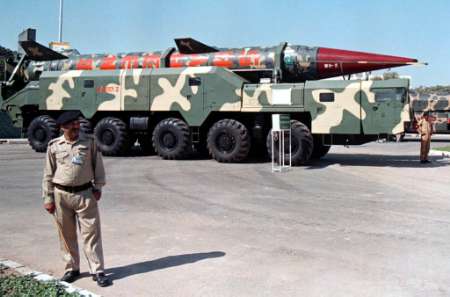
|
|
|
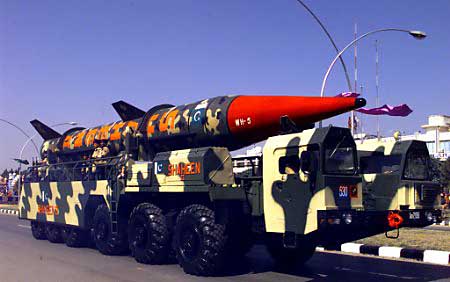
|
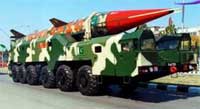
|
|
|
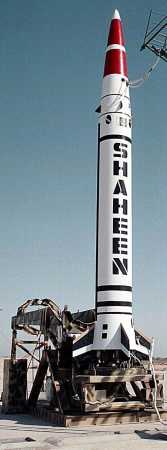 Thursday 15 April 1999Shaheen 1, the first in a new series of surface-to-surface missiles, rests on a launch pad 15 April 15 near Karachi, Pakistan. Pakistan tested a second nuclear-capable missile Thursday, upping the ante in the race with its uneasy neighbor India. (Defense Ministry) |




